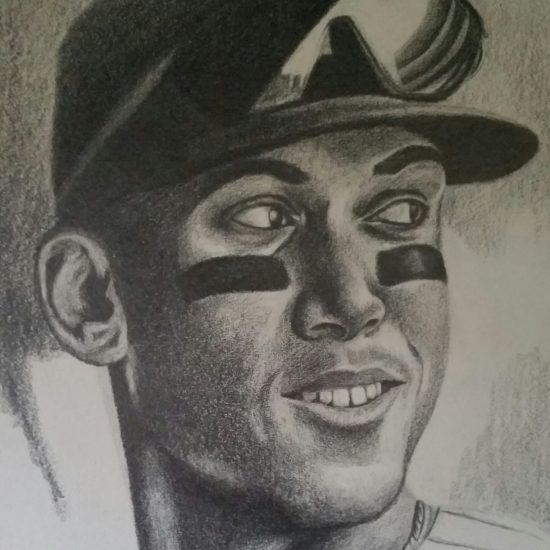This past offseason, Pitcher List introduced Pitch Level Value, or PLV, a new metric that assesses player performance by grading outcomes on the single pitch level. If you’re new to it, you can read Nick Pollack’s primer on PLV here.
You’ll find the definitions below. Grades are on a 20-80 scale.
Swing Aggression: How much more often a hitter swings at pitches, given the swing likelihoods of the pitches they face.
Strikezone Judgement: The “correctness” of a hitter’s swings and takes, using the likelihood of a pitch being a called strike (for swings) or a ball/HBP (for takes).
Decision Value (DV): Modeled value (runs per 100 pitches) of a hitter’s decision to swing or take, minus the modeled value of the alternative.
Contact Ability: A hitter’s ability to make contact (foul strike or BIP), above the contact expectation for each pitch.
Power: Modeled number of extra bases (xISO on contact) above a pitch’s expectation, for each BBE.
Hitter Performance (HP): Runs added per 100 pitches seen by the hitter (including swing/take decisions), after accounting for pitch quality.
Pitch Level Value (PLV): Estimated value of all pitches, based on the predicted outcome of those pitches (0-10, 5 is league average).
Pitch Level Average (PLA): Value of all pitches (ERA Scale), using IP and the total predicted run value of pitches thrown.
Pitch type PLA: Value of a given pitch type (ERA scale), using total predicted run values and an IP proxy for that pitch type (pitch usage % x Total IP).
(Note: All PLV data is current through Thursday, 7/6).
With the All-Star Game a few days away, let’s take a moment to appreciate the ridiculous season that this guy is having; He’s the only player in NL/AL history with 20 HR, 40 SBs, and 50 RBI before the mid-season break.
Sure, the new rule changes and all. Still, this is an unheard-of season. As Scott Youngson mentioned in his NL PLV All-Stars article, Acuña Jr. is, in fact, the only player with a 60 or better rating in each PLV category; Mookie Betts falls short with a 55 in contact ability.
Acuña Jr. has reached new heights this year thanks to slicing his K rate from 23.4% to 12.6%, reflected by a bump in contact ability from 50 to 60. And his power has gone up from 60 to 65; His average EV has soared to 94.9, second only to Aaron Judge among qualifiers. And sure, why not? He’s also upped his Decision Value from 60 to 65 this year.
Speaking of which, this looks like a pretty decent way to end the first half.
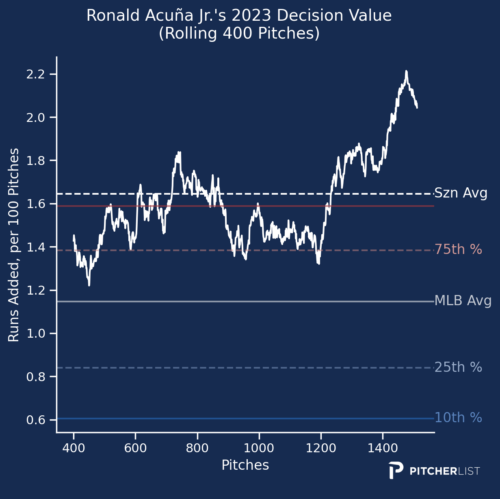
Thursday night, Julks stole his 15th base and now leads the Astros. Since June 1st, he’s slashing .319 / .396/ .468. Overall, his PLV grades aren’t great: SZ Judgement (40), DV (35), Contact (50), Power (45), and HP (55). But I really like that we’re seeing his contact ability on the rise.
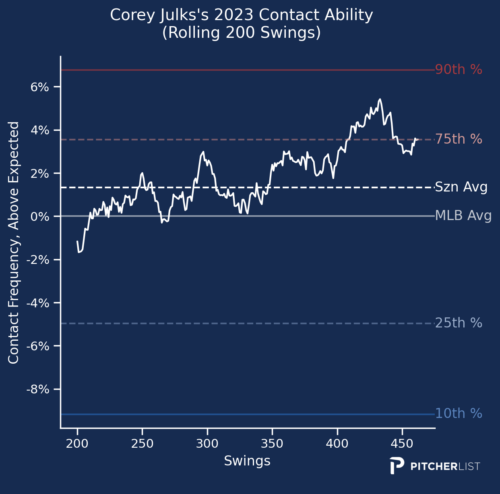
This seems, to me at least, like a hitter who is getting more comfortable at the big-league level. Julks posted a .854 OPS with a 9.5% BB and 21.5% K rate across 130 games with Triple-A Sugar Land in the PCL last season. I’m not sure how his playing time will shake out once the Astros are at full strength, but he’s definitely doing enough right now to warrant attention.
On Thursday, Lynn tossed a dominant outing against the Blue Jays: Seven innings, no runs, and 11 strikeouts. The start (102 pitches) earned a 5.33 PLV, his third-highest mark of the year (May 5th at CIN 5.55 PLV and April 11th at MIN 5,48 PLV). I’ll stop short of trying to predict what we’ll see next from the enigmatic right-hander and simply note that his fastball (5.34 PLV / 2.89 PLA) and cutter (5.89 PLV / 0.97 PLA) graded out really well, which I guess is a good sign, right? Last week, I mentioned that he threw his slider a bunch against the Angels on 6/28, but he only threw seven sliders here against the Jays. For more on Lynn, check out Tim Cheng’s Going Deep.
Suwinski is coming in hot with a 1.224 OPS over his last 12 games. The .236 average is a little bit of a drag in standard settings, but as someone who admires dingers and walks, he reminds me of one of my favorite crushes — Max Muncy. Suwinski joins Shohei Ohtani and Joey Gallo as the only hitters with 80-grade power (450 pitches minimum). And he’s fifth among qualifiers with a 15.8% BB rate. He’s also consistently shown elite-level Decision Value. Be still my beating heart.
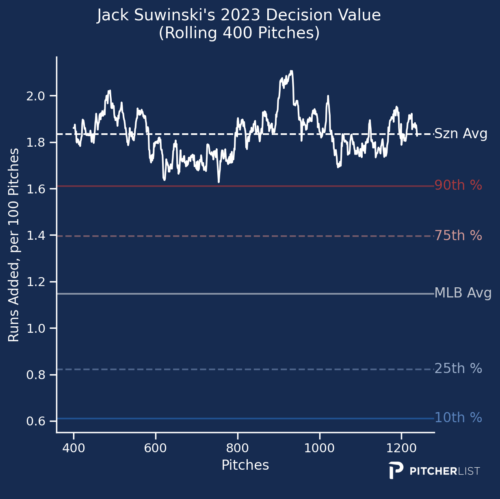
As mentioned, Ohtani, Suwinski, and Gallo are the only hitters with 80-grade power. Matt Olson’s power has climbed from 65 to 75. But I don’t think he’s satisfied and is on a mission with a 1.484 OPS over his last 12 games.
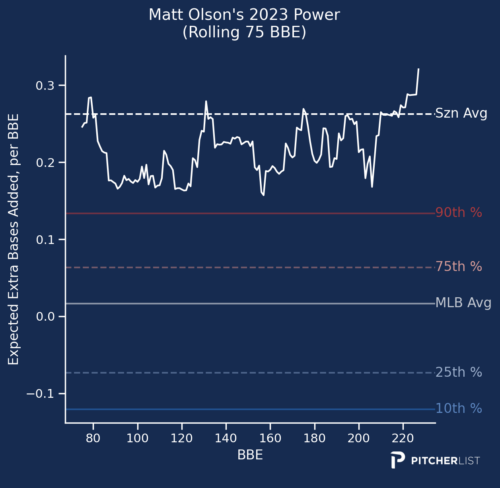
The Big Maple gets my vote for Comeback Player of the Year. He’s been nothing short of dominant, with a 2.70 ERA, 0.96 WHIP, and a 31.1% K rate over nine starts. I was a little surprised when I looked at his PLV pitch quality metrics; They aren’t bad by any means, but I guess relatively tame compared to his surface numbers. His fastball has been good, but the rest rates more toward the middle of the road.
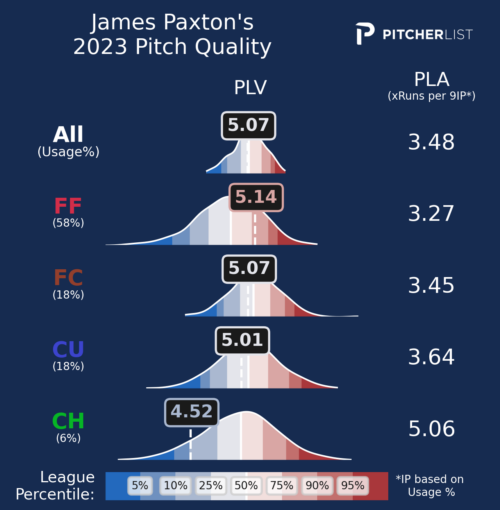
He recently joined the Home Run Derby and it makes perfect sense, given his power breakout. Last year, Robert Jr. had a 13.4% swing aggression, meaning he was one of the more aggressive hitters in the league; In fact, only five other hitters had a higher Swing aggression % (550 pitches minimum). Overall this year, he’s reined that in a little at 6.7%. However, we’ve recently seen a recent spike in his swing aggression, which has led to a concomitant surge in power.

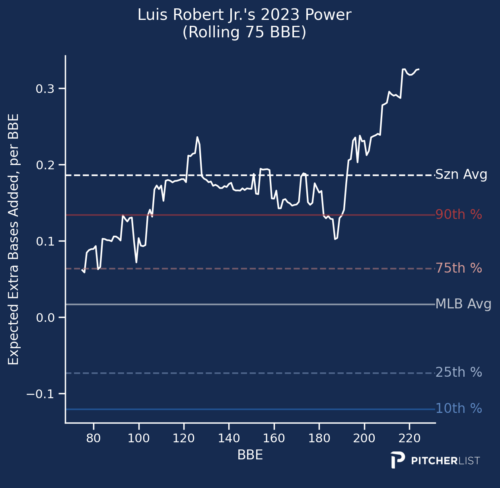
The quality of his swings and takes are still below average and, actually, a little worse than last year at 40, down from 45. But the gains in power are legit (55 to 70) and might be the result of a small trade-off in contact ability (55 to 50).
NL All-Star Starting Pitchers
With the All-Star Game on the horizon, let’s take a look at the roster.
Josiah Gray’s best pitch, the slider, has recorded a not-so-great 4.97 PLV / 3.95 PLA, so we should probably see his 3.41 ERA regress in the second half. But, hey, it’s understandable since the Nats need someone at the game.
Bryce Elder’s slider (5.19 PLV / 3.00 PLA) grades out a little better than Gray’s. But judging by his below-average 4.87 PLV, he’s probably overshot his 2.45 ERA the most.
Among NL SPs with at least 1,200 pitches thrown, Zack Wheeler is first with a 5.43 PLV. But this is the All-Star Game, so his unsightly 4.03 ERA will take a seat.
Spencer Strider’s 3.66 ERA is just about a full run higher than last year, but his 5.34 PLV is even better than last year’s 5.24. His 2.04 fastball PLA leads all starters with at least 1,200 pitches; Gerrit Cole is second at 2.44.
Despite a rough 4.93 ERA, Sandy Alcantara is third with a 5.31 PLV among all NL SPs.
Aaron Nola (5.29 PLV) and Logan Webb (5.26 PLV) are two more NL SPs that the PLV machine would also probably vote onto the roster.
He hasn’t pitched as much as the others here, but Braxton Garrett (1,324 pitches) is another NL SP who has graded out really well with a 5.20 PLV.
A.L. All-Star Starting Pitchers
George Kirby replaced Shane McClanahan on the AL roster and I think the PLV machine would approve. The 25-year-old Rye native’s 2.55 PLA is second among A.L. SPs with at least 1,200 pitches thrown.
Shohei Ohtani’s slider has been phenomenal. You’re surprised, I know. It’s 1.92 PLA ranks eighth, just behind one of his N.L. counterparts, Marcus Stroman (1.91). The rest of Ohtani’s arsenal, though, has been slightly below average, which feels almost sacrilegious to say. His splitter usage has been nearly halved, dropping from 12% to 7%. The pitch hasn’t graded as well this year, its PLA having risen from 2.01 to 3.76. Still, knowing that splitters can be mercurial, it’s not exactly worrisome, and, you know, it’s Ohtani.
Sonny Gray’s 2.50 ERA is third among qualifiers. His pitch quality metrics are impressive and should make you feel pretty good about his outlook in the second half. So far, his slider has taken the biggest leap with a 2.04 PLA relative to last year’s 2.54.

Nathan Eovaldi didn’t end the first half on a high note and struggled in his most recent start, a return to his old stamping grounds at Fenway Park. The lackluster performance netted a 4.57 PLV, his lowest grade all season. Eovaldi’s success is tethered pretty tightly to his fastball velocity, which was down nearly two ticks in Boston. That’s something to keep a close eye on when we open the second half.
Your top A.L. snubs based only on PLV (1,200 pitch minimum) are:
Clarke Schmidt (5.37 PLV): For some reason, PLV likes Schmidt a lot, but the results have been underwhelming.
Pablo López (5.35 PLV): Tossed A studly CGSO his last time out against KC. The performance earned a 5.58 PLV / 1.34 PLA. He’s thrown just one start that’s earned a PLV under 5.00.
JP Sears (5.32 PLV): I do like Sears a bit, but I feel like a lot of this grade is from the low BB rate.
Kyle Bradish (5.30 PLA): Great 1.04 PLA slider that is in a league of its own.
Joe Ryan (5.28 PLV): Ryan bounced back nicely after the dud against Atlanta with a solid start against KC, which earned a 5.29 PLV.
Zach Eflin (5.27 PLV) He also rated out well last year with a 5.24 PLV.
and Hunter Brown (5.26 PLV) Brown’s slider isn’t quite as dominant as Bradish’s, but its 2.11 PLA is still excellent.
I’m sure there were a few snubs that stuck out more, Fernando Tatis Jr., for one. But I’m admittedly biased since I’ve been a Ketel Marte fan for years; He was one of the very first players I ever wrote about on PL just before he busted out in 2019, so his omission chapped my hide. One thing I speculated about a few years back was his ability as a left-handed hitter since he had shown better EVs from his natural right-handed side. His splits have evened this season with a .367 wOBA as a lefty and .380 as a righty. Sure enough, as Esteban Rivera recently penned on FanGraphs, it appears that lefty Marte is leveling up.
Among all qualified second basemen, Marte is second with a .371 wOBA. His PLV grades are impressive across the board, including a bump in DV from 50 last year to 60. His one weakness is a 45 in power. But he had his best month yet with a 1.040 OPS in June, and things were getting steamy.
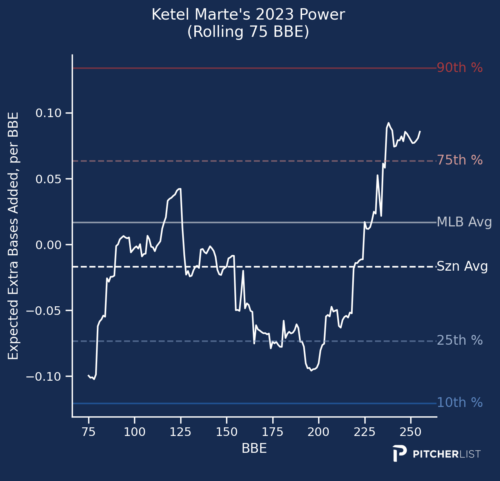
An ascension for sore eyes. Needless to say, I’m excited to see what he can do in the second half.
Photo by Ric Tapia/Icon Sportswire | Adapted by Justin Paradis (@JustParaDesigns on Twitter)

